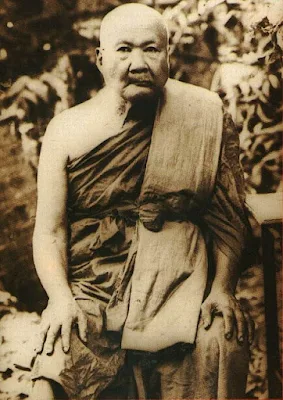Biography of Luang Pu Poo (Lp Pu / Lp Phu) — Wat Intharawihan, Bangkok
Born BE 2391 (1848) • Passed BE 2476 (1933) • Direct disciple of Somdej Phra Buddhachan Toh • Preserver of the Phra Somdej lineage
In an old quarter of Bangkok where the Chao Phraya breathes mist over temple roofs, a young novice named Poo bowed daily before his teacher — Somdej Phra Buddhachan (Toh Phrommarangsi) of Wat Rakhang. He came from a devout household, ordained early at Wat Intharawihan, and threw himself into the grammar of practice: Dhamma study, meditation, and the sacred sciences behind ritual and amulet making.
Under Somdej Toh’s eye he learned the slow, exacting method for Phong Itthijay, Phong Maha Lap, and Phong Maha Ud — powders folded through prayer and restraint until they felt less like ingredients than memory made tangible. When Somdej Toh passed in BE 2415 (1872), Luang Pu Poo stayed with the work: caring for Wat Intharawihan, deepening meditation, and carrying the lineage forward without fuss or claim.
As abbot, he guided the community and helped steward the completion of the temple’s towering image, Phra Buddha Sri Ariyametri (Luang Pho To). People came for counsel and for the Phra Somdej he pressed in the Wat Rakhang tradition — objects meant not for trade but as anchors for practice. By the time he passed in BE 2476 (1933), the monk the city called simply “Luang Pu Poo” had become a reference point: a quiet guardian of a crucial chapter in Thai Buddhist craft and devotion.
Early Life & Ordination
- Birth: BE 2391 (1848), Rattanakosin period (Rama III).
- Temple: Ordained and served at Wat Intharawihan, Bangkok.
- Focus: Dhamma, meditation, and wicha — the ritual sciences supporting consecration.
Training under Somdej Toh (Wat Rakhang)
- Direct disciple entrusted with Somdej powder preparation and meditation discipline.
- Mastered Phong Itthijay, Maha Lap, Maha Ud; learned iconographic and ritual grammar for Somdej.
- Preserved the lineage methods and transmitted them at Wat Intharawihan.
Role as Abbot of Wat Intharawihan
- Oversaw progress toward the giant standing Buddha (Phra Buddha Sri Ariyametri, Luang Pho To).
- Developed the temple as a center for Dhamma and meditation.
- Continued consecration of sacred objects in the Somdej tradition.
Sacred Amulets & Contributions
- Phra Somdej Wat Intharawihan (Nur Phong, BE 2468).
- Classic prints: Pim Yai, Pim Lek, Pim Prok Pho.
- Back forms: Lang Yant / Lang Rakang / Lang U.
- Other objects: Takrut and blessed items per Wat Rakang method.
Reputed blessings: klaew klaad (avoidance of danger), metta mahaniyom (charm), maha pokasap (prosperity), and inner steadiness.
Story: “Powders at Dawn”
Old stewards recalled a habit: before dawn bells, the abbot would sit by a shallow tray. Powders — Itthijay, Maha Lap, Maha Ud — lay like pale dunes. He did not speak. He breathed, traced a yan with a fingertip, then paused as if listening for a reply. When he finally pressed the moulds, they said, the room felt lighter. “An amulet doesn’t carry our wishes,” he once told a young monk, “it reminds us to wish well — and to act like it.”
Final Years & Legacy
- Passing: BE 2476 (1933), aged 85.
- Legacy: A standard-bearer of Somdej craft at Wat Intharawihan; a teacher whose quiet discipline shaped Bangkok’s devotional life.
- Enduring Influence: Devotees continue to venerate his line; Wat Intharawihan remains a site of pilgrimage linked to Somdej Toh.

